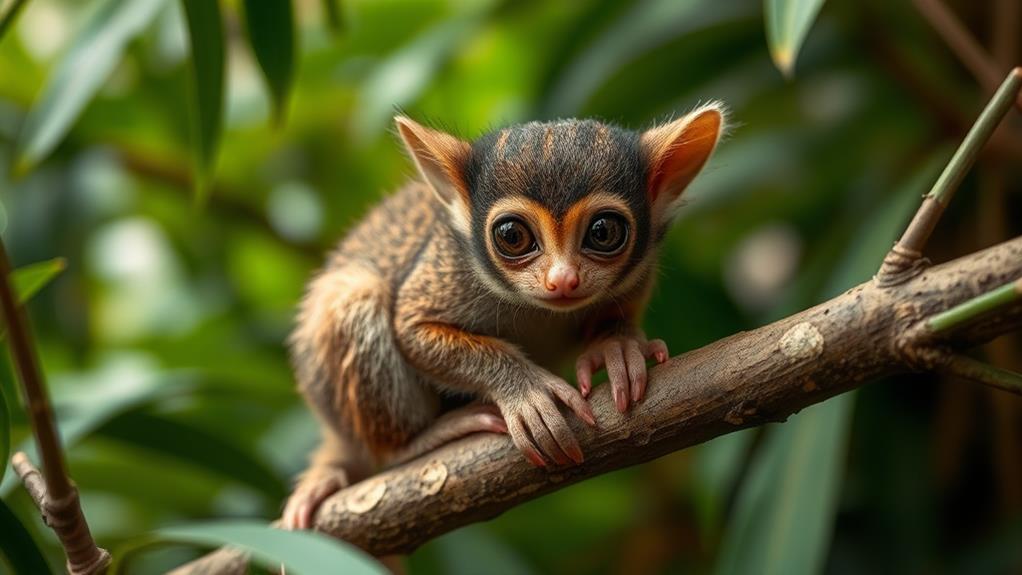Where do Philippine tarsiers live?
Philippine tarsiers, scientifically known as *Carlito syrichta*, inhabit the dense rainforests of Mindanao, Bohol, and Leyte.
What are their physical characteristics?
These tiny primates measure 3.3 to 6.3 inches in size, but have enormous eyes that are crucial for their nocturnal hunting activities.
What do they eat?
Philippine tarsiers are carnivorous, feeding on insects and small vertebrates. They utilize their exceptional sensory skills to navigate their territory and locate prey.
How do they interact with each other?
These primates form monogamous bonds and communicate with each other through vocalizations and grooming.
What threatens their survival?
Unfortunately, habitat destruction and the illegal pet trade pose significant threats to their survival, leading to their Near Threatened status.
Why are they important?
Understanding the unique behaviors and challenges of Philippine tarsiers reveals the importance of their ecological role and the need for conservation efforts to protect them.
Geographic Distribution and Habitat

The Philippine tarsier inhabits specific habitats across the Mindanao region and neighboring islands like Bohol and Leyte in the southeastern Philippines. These habitats include both primary and secondary rainforests, which provide dense, bushy vegetation that supports their diet of insects.
They can be found in elevations ranging from sea level to 2,460 feet (750 meters), showcasing their adaptability in diverse forest types.
Habitat loss and fragmentation significantly affect tarsier populations, particularly in disturbed areas. When their natural environments are compromised, tarsiers experience lower population densities, threatening their long-term survival.
A male tarsier's home range typically spans 1 to 2 hectares, and they travel an average of 5,400 feet (1,600 meters) each night in search of food, highlighting the importance of habitat quality and availability of insects for their sustenance.
Preserving the tarsiers' natural habitats is essential for maintaining healthy populations of these unique primates in the Philippines.
Unique Characteristics and Taxonomy
Unique Physical Characteristics
The Philippine tarsier, scientifically known as *Carlito syrichta*, has several distinct physical features. It is one of the smallest primates, measuring between 3.3 to 6.3 inches in height. Notably, its eyes are the largest relative to its body size among mammals, with each eye measuring approximately 16 mm in diameter. This adaptation is crucial for its nocturnal hunting behavior, allowing it to navigate and hunt effectively in low-light environments.
Taxonomy and Classification
The classification of tarsiers is a subject of ongoing debate among researchers. While some group all tarsiers under the genus *Tarsius*, others propose different genera, such as *Carlito* and *Cephalopachus*. Currently, three recognized subspecies of the Philippine tarsier include *C. s. syrichta*, *C. s. fraterculus*, and *C. s. carbonarius*, which reflect their variations across distinct habitats within the Philippines.
Other Notable Characteristics
Philippine tarsiers have a unique upper lip structure that enhances their facial expressions, contributing to their social interactions. Additionally, they are unable to synthesize Vitamin C, aligning them with other haplorrhine primates and highlighting their shared evolutionary traits.
Size, Weight, and Lifespan

Philippine tarsiers are one of the smallest primate species in the world, with an average body length ranging from 4.5 to 5 inches (11-13 cm). Their small size is complemented by tails that are approximately twice their body length, allowing them to move agilely in the treetops.
Philippine tarsiers weigh between 4 and 5 ounces (110-130 grams). There's a difference in weight between males and females, with males generally heavier, averaging 118-130 grams, and females weighing around 102-114 grams.
Philippine tarsiers can live up to 13 years in captivity, but their lifespan in the wild is likely shorter. Environmental factors and predation may contribute to this difference.
Females typically cover a home range of about 2 hectares, while males may extend their territory to up to 3 hectares.
Diet and Hunting Behavior
Diet and Hunting Behavior of Philippine Tarsiers
Philippine tarsiers are nocturnal predators with a unique diet and hunting behavior. They are fully carnivorous, primarily consuming insects like moths, locusts, and beetles, as well as small vertebrates such as lizards and birds. Their exceptional hearing and large eyes enhance their ability to detect prey in the dark, allowing them to leap up to 20 feet (6 meters) to capture it mid-air.
Tarsiers spend about 55% of their active hours foraging for food, which highlights their high energy needs. They can consume up to 10% of their body weight in prey within a 24-hour period. Their hunting behavior is influenced by their territorial nature, as they mark their territory with scent, which also plays a role in communication.
Hunting Techniques and Communication Methods:
- Insects are captured mid-air using their leaping ability, and they use scent marking for communication.
- Small vertebrates are caught using exceptional hearing and eyesight, and territorial behaviors are used for communication.
Understanding these behaviors helps appreciate the tarsiers' role in their ecosystem.
Social Behavior and Communication

Social Structure and Monogamy
Tarsiers typically form small family units, and monogamous pair bonding is common, although some instances of facultative polygyny can occur.
Communication Methods
Tarsiers rely heavily on vocalizations for communication, including:
- High-pitched squeaks that serve as alarm calls
- Duet songs for territory maintenance
- Morning songs initiated by females to signal their return to sleeping sites
Tactile Communication
Grooming behaviors play a significant role in tarsier communication, especially between mothers and their offspring. This reinforces social bonds and strengthens familial ties.
Site Fidelity and Social Bonds
Tarsiers display high site fidelity, frequently returning to the same sleeping sites. This fosters familiarity and strengthens social structures within their groups.
Territorial Communication
Scent marking through urine and gland secretions is crucial for establishing boundaries and maintaining social hierarchies.
Importance of Social Behavior and Communication
Understanding these dynamics is essential for appreciating the complexity of tarsiers' social lives. Their social behavior and communication methods are vital for their survival in the wild.
Conservation Status and Threats
The conservation status of tarsiers is a concern. They're classified as Near Threatened by the IUCN, with estimates suggesting fewer than 2,500 individuals remain in the wild.
Habitat loss is a primary threat. Agricultural expansion and urbanization have led to significant declines in populations, with some areas experiencing over 30% habitat destruction between 1978 and 2008.
This loss of habitat is particularly problematic for the Philippine tarsier, a nocturnal animal with specialized dietary needs.
Captivity isn't a viable solution. Captured tarsiers often die within two years, highlighting the challenges of maintaining a viable population in unnatural settings.
This is due to their high mortality rates in captivity.
The illegal pet trade poses a substantial threat. Individuals are sought after as exotic pets, particularly in urban areas like Manila and Mexico, further straining population estimates.
Conservation initiatives are crucial. These efforts focus on habitat preservation, implementing stricter regulations on capture and trade, and promoting community education to raise awareness about the tarsier's plight.
Questions and Answers
How Are Philippine Tarsiers Adapted to Their Habitat?
Philippine tarsiers are nocturnal animals, and their exceptional night vision allows them to hunt effectively in the dark. This adaptation is crucial for their survival, as they feed on small insects and invertebrates that are most active at night.
Agile hunting techniques are another key adaptation of Philippine tarsiers. They can move swiftly and silently through the trees, using their long legs and sharp claws to catch their prey. This agility also helps them to avoid predators and navigate their dense forest habitat.
Philippine tarsiers also exhibit territorial behavior, which plays a crucial role in their mating rituals and communication. They mark their territories using scent and vocalizations, warning other tarsiers to stay away. This behavior helps to reduce competition for resources and ensures that they can find a mate.
To avoid predators, Philippine tarsiers have developed a unique adaptation – the ability to rotate their heads 180 degrees. This allows them to scan their surroundings without moving their entire body, making it harder for predators to detect them.
They also rely on dense vegetation to conceal themselves, using their small size and camouflage to blend in with their surroundings.
What Is the Tarsiers Habitat?
The tarsier's habitat is found in diverse forest ecosystems. These ecosystems include secondary forests and mangroves, which provide the necessary environment for the tarsier's nocturnal lifestyle.
The dense foliage in these forests supports the tarsier's diet preference for insects.
Habitat destruction poses a significant environmental threat to tarsiers. This destruction affects their geographic distribution and social structure.
Effective conservation efforts must address habitat destruction to ensure the tarsier's breeding habits and overall well-being remain intact within their natural habitats.
What Is a Tarsiers Behavior?
Tarsiers exhibit complex social behavior. They engage in various social interactions, including grooming behaviors, such as licking and cleaning each other, and mating rituals, which involve vocalizations and visual displays.
Nocturnal hunting is a key survival strategy. Tarsiers use their keen senses, including exceptional night vision and acute hearing, to catch prey. They also employ predator evasion strategies, such as freezing in place or fleeing quickly, to avoid becoming prey themselves.
Communication is crucial for tarsiers. They use various vocalization types, including high-pitched chirps and loud, piercing calls, to convey information. Alarm calls are used to signal threats, alerting other tarsiers to potential dangers.
Territorial behavior is important for tarsiers. They mark their territories using scent and vocalizations, and engage in infant care practices, such as carrying and grooming their young, to ensure their safety while foraging.
Tarsiers exhibit stress response behaviors. In challenging situations, they display emotional states, such as fear or anxiety, through changes in their behavior, such as increased vocalization or agitation.
What Are the Small Primates in the Philippines?
The Philippines is home to a unique small primate, the tarsier. This nocturnal animal plays a vital role in maintaining ecological balance in its habitats. Its distinctive social structure, which involves living in solitude or in pairs, contributes to primate diversity. In addition to its ecological importance, the tarsier also holds cultural significance for indigenous communities in the Philippines. Efforts to protect these primates are closely tied to indigenous rights in resource management, as these communities rely on the sustainable management of their natural resources for their livelihoods. In recognizing the interconnectedness of ecological preservation and indigenous rights, efforts can be made to ensure the conservation of the tarsier and its habitats while also respecting the rights of the indigenous communities.
Habitat destruction and wildlife tourism threaten the tarsier's survival. The destruction of its natural habitats and the capture of tarsiers for the pet trade or tourist attractions put these creatures at risk.
To address these threats, conservation efforts focus on protecting tarsiers and studying their behavior.
Understanding tarsiers' feeding strategies and reproductive behavior is crucial for their survival. For example, tarsiers primarily feed on insects, and their unique way of hunting at night helps maintain the balance of insect populations in their ecosystems.